|
|
 |
Edward William Cooke
|
|
British Painter, 1811-1880
was an English painter and gardener. Cooke was born in London. His father George and uncle, William Bernard, were both well-known engravers and Cooke was raised in their wide artistic circle. He was a precocious draughtsman and a skilled engraver from an early age, displayed an equal preference for marine subjects and published his 'Shipping and Craft' C a series of accomplished engravings C when he was 18, in 1829. He benefited from the advice of many of his father's associates, notably Clarkson Stanfield (whose principal marine follower he became) and David Roberts. Cooke began painting in oils in 1833, took formal lessons from James Stark in 1834 and first exhibited at the Royal Academy and British Institution in 1835, by which time his style was essentially formed. He went on to travel and paint with great industry at home and abroad, indulging his love of the 17th-century Dutch marine artists with a visit to Holland in 1837. He returned regularly over the next 23 years, studying the effects of the coastal landscape and light, as well as the works of the country's Old Masters, resulting in highly successful paintings. These included 'Beaching a Pink at Scheveningen' (National Maritime Museum, London), which he exhibited in 1855 at the Royal Academy, of which he was an Associate from 1851. He went on to travel in Scandinavia, Spain, North Africa and, above all, to Venice.") Cooke was "particularly attracted by the Isle of Wight, and on his formative visit of 1835 he made a thorough study of its fishing boats and lobster pots; above all he delighted in the beaches strewn with rocks of various kinds, fishing tackle, breakwaters and small timber-propped jetties He also had serious natural history and geological interests, being a Fellow of the Linnean Society, Fellow of the Geological Society and Fellow of the Zoological Society, |
|
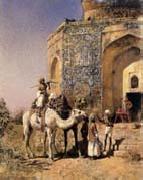 |
Edwin Lord Weeks
|
|
American Academic Painter, 1849-1903, American artist, was born at Boston, Massachusetts, in 1849. He was a pupil of Leon Bonnat and of Jean-Leon Gerome, at Paris. He made many voyages to the East, and was distinguished as a painter of oriental scenes. In 1895 he wrote and illustrated a book of travels, From the Black Sea through Persia and India, and two years later he published Episodes of Mountaineering. He died in November 1903. He was a member of the Legion d'honneur, France, an officer of the Order of St. Michael, Germany, and a member of the Secession, Munich. |
|
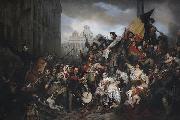 |
Egide Charles Gustave Wappers
|
|
(23 August 1803 Antwerp - 6 December 1874 Paris) is best known as the Belgian painter Gustave Wappers, while his oeuvre is also reckoned Flemish. He signed works by the name Gustaf Wappers.
He studied at the Royal Academy of Fine Arts in Antwerp, and during 1826 in Paris. The Romantic movement with its new ideas about art and politics was astir in France. Wappers was the first Belgian artist to take advantage of this state of affairs, and his first painting, "The Devotion of the Burgomaster of Leiden," appeared at the appropriate moment and had marvellous success in the Brussels Salon during 1830, the year of the Belgian Revolution. While political, this remarkable work revolutionized the direction of Flemish painters.
Episode of the Belgian Revolution of 1830 (1834), Museum of Ancient Art, Brussels.Wappers was invited to the court at Brussels, and was favoured with commissions. In 1832 the city of Antwerp appointed him Professor of Painting. He exhibited his masterpiece, "Episode of the Belgian Revolution of 1830" or rather "Episode of the September Days of 1830 on the Grand Place of Brussels", (Museum of Ancient Art, Brussels) at the Antwerp Salon in 1834. He was subsequently appointed painter to Leopold, King of the Belgians. At the death of Matthieu-Ignace Van Bree in 1839 he was elavated to director of the Antwerp Academy. One of his pupils was Ford Madox Brown; another was the Czech history painter Karel Javůrek.
His works are numerous; some of them in traditional devotional modes ("Christ Entombed"), while others illustrate the Romantic view of history: "Charles I taking leave of his Children", "Charles IX", "Camoens", "Peter the Great at Saardam", and "Boccaccio at the Court of Joanna of Naples".
Louis Philippe gave him a commission to paint a large painting for the gallery at Versailles, "The Defence of Rhodes by the Knights of St John of Jerusalem". He finished the work in 1844, the same year that he received the title of baron from Leopold I.After retiring as director of the Antwerp Academy, he settled in 1853 in Paris, where he died in 1873 - having been one of the most talented flagships of Romanticism in Belgium.
|
|
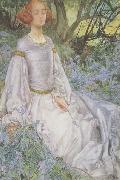 |
Eleanor Fortescue-Brickdale,RWS
|
|
1872-1945
English illustrator, painter and designer. She entered the Royal Academy Schools, London, and won a prize for a mural design in 1897. She specialized in book illustration, in pen and ink and later in colour. Among her many commissions were illustrations to Tennyson's Poems (1905) and Idylls of the King (1911) and Browning's Pippa Passes (1908). She was particularly popular with the publishers of the lavishly illustrated gift-books fashionable in the Edwardian era. She exhibited regularly at the Royal Academy and the Royal Water-Colour Society. She took up stained-glass design (windows in Bristol Cathedral), which modified her style of illustration to flat areas of colour within black outlines. |
|
|
|
|
|
|
|
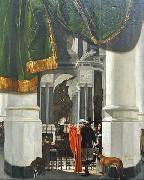 |
Emanuel de Witte
|
|
(1617 - 1692) was a Dutch perspective painter. In contrast to Pieter Jansz Saenredam, who emphasized architectural accuracy, De Witte was more concerned with the atmosphere of his interiors. Though few in number, de Witte also produced genre paintings.
De Witte was born in Alkmaar and learned geometry from his father, a schoolmaster. He joined the local Guild of St Luke in 1636. After a stay in Rotterdam, he moved to Delft and studied with Evert van Aelst. In 1651 de Witte settled in Amsterdam where his first wife, Geerje Arents, died in 1655. He then married a 23-year-old orphan, Lysbeth van der Plas, who exercised a bad influence on de Witte's adolescent daughter. In December 1659 both were arrested for theft from a neighbor.Lysbeth, pregnant, had to leave the city for a period of six years; she lived outside the city walls and died in 1663.
Following the arrest of his wife and child, de Witte was forced to indenture himself to the Amsterdam notary and art dealer Joris de Wijs, surrendering all of his work in exchange for room, board, and 800 guilders annually. De Witte broke the contract, was sued by the dealer, and forced to indenture himself further as a result. Several patrons provided de Witte with support, but these relations did not work out well, for he tended to shout at his clients and at people watching him at work in churches. Records tell of his gambling habit and a fight with Gerard de Lairesse. According to Arnold Houbraken, after an argument about the rent, de Witte hanged himself from a canal bridge in 1692. The rope broke and de Witte drowned. Because the canal froze that night, his corpse was not found until eleven weeks later
|
|
 |
Emmanuel de Witte
|
|
Dutch
1617-1692
Emmanuel de Witte Gallery
Dutch painter. He was one of the last and, with Pieter Saenredam, one of the most accomplished 17th-century artists who specialized in representing church interiors. He trained with Evert van Aelst (1602-57) in Delft and in 1636 joined the Guild of St Luke at Alkmaar, but he was recorded in Rotterdam in the summers of 1639 and 1640. In October 1641 his daughter was baptized in Delft, where he entered the Guild of St Luke in June 1642 and lived for a decade, moving to Amsterdam c. 1652. He began his long career as an unpromising figure painter, as can be seen in the Vertumnus and Pomona (1644) and two small pendant portraits (1648; all Rotterdam, Mus. Boymans-van Beuningen). |
|
|
|
 |
Enoch Wood Perry, Jr.
|
|
(1831-1915) was a painter from the United States.
Perry was born in Boston on July 31, 1831. His father was Enoch Wood Perry, and mother was Hannah Knapp Dole. His maternal grandparents were Samuel Dole and Katherine Wigglesworth. The family moved to New Orleans with his family as a teenager in 1848 and attended its public schools. After working several years as a clerk in a commission house, Perry began formal art education. In 1852 he went to Europe for four years and studied with Emanuel Leutze at the Desseldorf Academy, Thomas Couture in Paris, and in Rome.Perry served as the U.S. Consul to Venice between 1856 and 1858. Upon returning to America, he opened a studio in Philadelphia. |
|
|
|
|
|
|
|
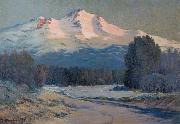 |
Ernst William Christmas
|
|
(1863-1918) was an Australian painter. He was born near Adelaide, South Australia in 1863 and studied art in Adelaide, Sydney and in London. He painted widely in England, exhibiting in the early years of the century at the Royal Academy, the Royal Institute of Oil Painters, the Royal Society of British Artists, the Royal Glasgow Institute of Fine Arts and in the provinces.
He was elected to the British Royal British Academy in 1909. In 1910-11, he painted mountains and lakes in Argentina and Chile. He lived in San Francisco around 1900 and again around 1915. He was an avid traveller, but spent the last two years of his life in Hawaii, where he painted landscapes including dramatic volcano scenes. Ernest William Christmas died in Honolulu in 1918.
|
|
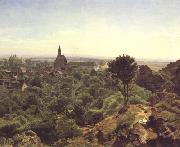 |
Ferdinand Georg Waldmuller
|
|
Austrian Romantic Painter, 1793-1865
was an Austrian painter and writer. He briefly attended the Academy of Fine Arts Vienna, however later had to finance his life by painting portraits. In 1811 he got a job as a teacher of arts for the children of Count Gyulay in Croatia. After 3 years he returned to Vienna and started to improve his skills by copying the works of old masters. Waldmeller later became interested in nature and thus started painting landscapes (genre painting). His most notable work lies in the depiction of nature, where his sense for colours and large knowledge of nature helped him to achieve masterly skills. In 1823 he made a painting of Ludwig van Beethoven. He was professor at the Academy of Fine Arts Vienna, |
|
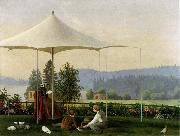 |
Ferdinand von Wright
|
|
1822-1906,Brother of Magnus von Wright and Wilhelm von Wright. He grew up under the influence of his brothers and became a skilled ornithological illustrator at a very young age. He remained in Sweden from 1837 until 1844 and worked as a draughtsman, helping his brother Wilhelm. After returning to Finland he set his sights on a career as a painter. During the second half of the 1840s he was still searching for his proper path, and he experimented with a number of subjects: birds, still-lifes, landscapes and portraits. |
|
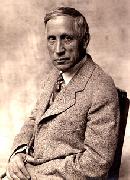 |
Fiske Warren
|
|
Frederick Fiske Warren (2 July 1862-2 February 1938) was a hugely successful Paper Manufacturer, fine arts denizen and major supporter of Henry George's Single Tax system which he helped develop in Harvard, Massachusetts, United States in the 1930's. He was the son of Samuel Dennis Warren and Susan Cornelia Warren of Beacon Hill, Boston, Massachusetts and the brother to Samuel D. Warren (US attorney) and Edward Perry Warren.
Born in Waltham, Massachusetts, Fiske was raised in a mansion on 67 Mount Vernon Street[1] in Beacon Hill, Boston, Massachusetts. A philanthropic and highly educated family, the Warren brothers and sisters all enjoyed tranquil childhoods growing up between the family homes in Boston and Waltham, Massachusetts, also known as "Cedar Hill".
|
|
|
|
 |
Francis Wheatley
|
|
1747-1801
British Francis Wheatley Location
Francis Wheatley (1747 - June 28, 1801), was an English portrait and landscape painter, was born at Wild Court, Covent Garden, London. He studied at Shipleys drawing-school and the Royal Academy, and won several prizes from the Society of Arts. He assisted in the decoration of Vauxhall, and aided Mortimer in painting a ceiling for Lord Melbourne at Brocket Hall (Hertfordshire). In youth his life was irregular and dissipated. He eloped to Ireland with the wife of Gresse, a brother artist, and established himself in Dublin as a portrait-painter, executing, among other works, an interior of the Irish House of Commons. His scene from the Gordon Riots of 1780 was engraved by Heath. He painted several subjects for Boydells Shakespeare Gallery, designed illustrations to Bells edition of the poets, and practised to some small extent as an etcher and mezzotint-engraver. It is, however, as a painter, in both oil and water-color, of landscapes and rustic subjects that Wheatley is best remembered. He was elected an associate of the Royal Academy in 1790, and an academician in the following year. His wife, as Mrs Pope after his death, was known as a painter of flowers and portraits. |
|
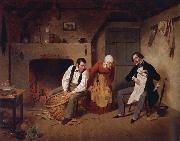 |
Francis William Edmonds
|
|
American, 1806-1863,American painter and banker. He achieved recognition both as a painter and as a banker, juggling careers with consummate skill. In 1826 he enrolled at the National Academy of Design while working in a New York bank. Somewhat insecure, he initially exhibited between 1836 and 1838 under the pseudonym E. F. Williams, but favourable reviews subsequently prompted him to use his own name. In 1840-41 Edmonds spent eight months in Europe, where he studied the Old Masters; he particularly admired the 17th-century Dutch painters Pieter de Hooch and Gabriel Metsu. |
|
|
|
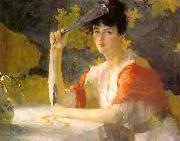 |
Frank Weston Benson
|
|
(March 24, 1862 - November 15, 1951) was an American Impressionist artist, and a member of the Ten American Painters.
Benson was born in Salem, Massachusetts. In 1879, he began study at the School of the Museum of Fine Arts, Boston under Otto Grundmann, and later at the Acad??mie Julian in Paris. Upon return to America, he would become an instructor at the School of the Museum of Fine Arts, Boston. Some of his best known paintings (Eleanor, Museum of Fine Arts, Boston; Summer, Rhode Island School of Design Museum) depict his daughters outdoors at Benson's summer home on the island of North Haven, Maine. He also produced numerous paintings and etchings of wildfowl.
Born into a successful merchant family, Benson lived in Salem for most of his life. At the Boston Museum school he befriended Edmund Charles Tarbell and Robert Reid, at the same time teaching drawing classes in Salem and painting landscapes during the summer. In 1883 he began his studies in Paris, and in the summer of 1884 painted at Concarneau, along with Willard Metcalf and Edward Simmons. His early paintings were conventional landscapes. |
|
|
|
|
|
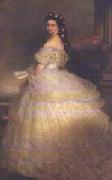 |
Franz Xaver Winterhalter
|
|
German 1805-1873
Franz Xaver Winterhalter Galleries
German painter and lithographer. He trained as a draughtsman and lithographer in the workshop of Karl Ludwig Scheler (1785-1852) in Freiburg im Breisgau and went to Munich in 1823, sponsored by the industrialist Baron Eichtal. In 1825 he began a course of study at the Akademie and was granted a stipend by Ludwig I, Grand Duke of Baden. The theoretical approach to art of the Akademie under the direction of Peter Cornelius was unfamiliar to him, as in Freiburg he had been required to paint in a popular style. He found the stimulus for his future development in the studio of Joseph Stieler, a portrait painter who was much in demand and who derived inspiration from French painting. Winterhalter became his collaborator in 1825. From Stieler he learnt to make the heads of figures emerge from shadow and to use light in the modelling of faces. He moved to Karlsruhe in 1830 with his brother Hermann Winterhalter (1808-92), who had also trained with Scheler and had followed him to Munich. |
|
|
|
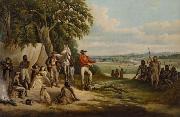 |
Frederick William Woodhouse
|
|
Frederick William Woodhouse
1820-1909
Woodhouse was born in Britain, but is better known as an Australian artist after his move to Australia. He painted images of Bush Life, and made many images from direct observation in sketchbooks and watercolors. He was also Australiaes most important horse racing painter, having painted every Melbourne Cup winner from 1861 until the introduction of the trackside camera. Although horses were his mainstay, Woodhouse also painted dogs, sheep, cattle, landscapes and portraits of persons. Between 1893 and 1894 he made a number of landscapes during a trip to Tasmania. |
|
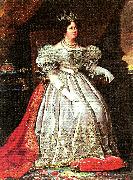 |
fredrik westin
|
|
Fredric Westin, född den 22 september 1782 i Stockholm, död 13 maj 1862 i Stockholm, historie- och porträttmålare.
Westin hade varit elev hos Lorens Pasch d.y. och Louis Masreliez på Konstakademien. Sedan han 1808 blivit kallad till akademiens agr?? och förordnad till konduktör vid kungliga museet blev han 1812 invald i Konstakademiens styrelse. Han blev 1815 vice professor och 1816 professor vid Konstakademien. Där var han också 1828-1840 direktör. 1843 utnämndes han till hovintendent.
Till hans tidigare skede och till hans främsta alster hör "Dagens stunder", fyra dörrstycken i Karl Johans sängkammare på Rosersbergs slott med antikiserande figurer: Aurora som strör blommor över jorden, Apollon med sitt fyrspann, Diana följd av Aftonrodnaden samt Natten med sitt stjärnströdda dok (1812-13). På Säfstaholms slott finns "De fyra årstiderna presiderade av jordens gudinna" (1843), på Rosendals slott "Hebe med örnen" (1832) och "Flora bekransande Linn??s byst" (1843) och vid Stockholms universitet "Musiken, föreställd av en grupp unga flickor". Han målade också kompositioner ur den svenska historien ("Olof Skötkonungs dop", "Lutherska lärans antagande").
Westin målade en stor mängd porträtt då han under Karl XIV Johans tid var konstnären på modet. Som porträttmålare var han dock inte enhälligt uppskattad. En kritiker som Silverstolpe beklagade 1809 att en konstnär som "äger så mycken färdighet till stöd för sitt sökande av idealet" sysselsatte sig med en konst av så lågt värde och hoppades att han "måtte återvända från den platta verkliga världen till den poetiska." Hammarsköld menade 1818 att av de svenska konstnärerna var det Westin som hade de ringaste anlagen för porträttmålning. Scholander kallade hans porträtt för "vaxgubbar". Andra hade lovord att fälla över Westins porträtt. Gerss ansåg att Westins porträtt hade likhet och behag i uttrycket, enkelhet i ställning och klädsel, urval av natur i formerna och säkerhet och sanning i utförandet. Wennberg kallade honom "den förste svenske tecknarens Lorenz Paschs så värdige fosterson".
Under Karl XIV Johans tid målade han rad porträtt på kungafamiljen. 1824 målade han en populär allegori över kronprinsessan Josefinas ankomst till Sverige, där Saga i gul och blå dräkt sitter på marken framför en runsten och blickar upp mot skyn där kronprinsessan i röd och vit dräkt svävar ned på en molntapp omgiven av tre amoriner. 1838 målade han Karl XIV Johan till häst på Ladugårdsgärdet hälsande med den trekantiga hatten.
Efter att Sandbergs altartavla för Sankt Jacobs kyrka hade underkänts vände sig de ansvariga till Westin med uppdraget att måla en altartavla. Målningen, "Kristi förklaring" var klar 1828 och resultatet blev både hyllat och kritiserat. Andra altartavlor av Westin finns i Kungsholms kyrka ("Kristi uppståndelse", 1825), Åbo domkyrka ("Kristi förklaring", 1836), Uddevalla kyrka ("Kristus välsignar barnen") samt Carl Gustafs kyrka ("Kristi begravning", 1832). |
|
|
|
|
|
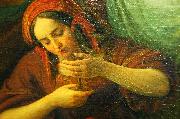 |
Friedrich Wilhelm Schadow
|
|
Friedrich Wilhelm Schadow (7 September 1789 - 19 March 1862) was a German Romantic painter.
He was born in Berlin and was the second son of the sculptor Johann Gottfried Schadow.
In 1806-1807 Friedrich served as a soldier. In 1810 he traveled with his elder brother Rudolph to Rome where he became one of the leaders among painters of the Nazarene movement. Following the example of Johann Friedrich Overbeck and others, he joined the Roman Catholic Church, and held that an artist must believe and live out the truths he essays to paint. The sequel showed that Schadow was qualified to shine more as a teacher and mentor than as a painter. As an author, he is best known for his lecture, Ueber den Einfluss des Christentums auf die bildende Kunst (About The Influence of Christianity On The Visual Arts) (Desseldorf, 1843), and the biographical sketches, Der moderne Vasari (Berlin, 1854).
In Rome, Schadow was given one of his first major commissions when the Prussian Consul-General, General Jakob Salomon Bartholdy, befriended the young painter, and asked him and three young compatriots (Cornelius, Overbeck and Veit) to decorate in fresco a room in his house on the Pincian Hill. The overall theme selected was the story of Joseph and his brethren, and two scenes, the Bloody Coat and Joseph in Prison, were conferred on Schadow. In 1819, Schadow was appointed professor in the prestigious Berlin Academy of the Arts, and his ability and thorough training gained many devoted disciples.
It was during this period that Schadow developed his paintings for churches. In 1826, Professor Schadow was made director of the Desseldorf Academy of the Arts, which he reoriented towards the production of Christian art, though he began a major dispute with one of its professors, Heinrich Christoph Kolbe, ending in the latter leaving the Academy in 1832. In 1837, Schadow selected, at request, those of his students best qualified to decorate the chapel of St Apollinaris on the Rhine with frescoes. When finished, they were acclaimed as the fullest and purest manifestation of the spiritual side of the Desseldorf school. One of his famous students, Heinrich Mucke, carried on the liturgical art with emphasis both in painting and frescoes. The painting of the "Wise and Foolish Virgins," considered one of his masterworks, was commissioned in 1842. Now in the Städel Museum, this large and important picture, while carefully considered and rendered, it however lacks power of some of his other works. |
|
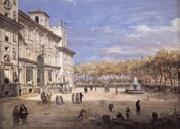 |
Gaspar Van Wittel
|
|
Dutch Baroque Era Painter, ca.1653-1736
was a Dutch landscape painter. Van Wittel learned painting in his hometown of Amersfoort. His first extant works were made in Hoorn in 1672, but he relocated to Rome with his family ca. 1675 and made his career there. In Amersfoort, he likely was exposed to Dutch landscape artists such as Jan van der Heyden and Gerrit Berckheyde. He married in Rome in 1697, and stayed most of his life in that city, though, between 1694 and 1710, he toured Italy and painted in places like Florence, Bologna, Ferrara, Venice, Milan, Piacenza and Naples. He is one of the principal painters of topographical views known as vedute. His son Luigi would become a famous architect and also carries the italianized family name of Vanvitelli. In Luigi's biography is written that his father was born in July 1656, |
|
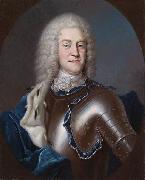 |
Georg Weissmann
|
|
painted Christian Ludwig II, Duke of Mecklenburg-Schwerin in 1731 |
|
|
|
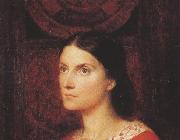 |
George Frederick watts,O.M.,R.A.
|
|
1817-1904
English painter and sculptor. He studied at the Royal Academy and in Italy, where he developed an enthusiasm for Renaissance painting and Greek sculpture that greatly influenced his work. He executed several decorative commissions, including his large fresco Justice (Lincoln's Inn, London), modeled after Raphael's School of Athens. Many of his allegorical pictures are in the Tate Gallery, London. The National Portrait Gallery, London, contains a large collection of his portraits of eminent contemporaries. The Metropolitan Museum has his Ariadne in Naxos. |
|
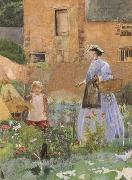 |
George John Pinwell,RWS
|
|
1842-1875
English illustrator and painter. He was born in humble circumstances and was largely untrained. He was briefly a student at St Martin's Lane Art School and at Heatherley's. From 1863 he contributed woodblock illustrations to magazines, establishing his reputation in 1865 with the Dalziel brothers' editions of The Arabian Nights and The Works of Oliver Goldsmith. Pinwell's finest drawings were commissioned for the Dalziels' poetry gift-books. With another illustrator, John William North (1842-1924), he worked at Halsway Manor in Somerset in 1865, experimenting with formal effects based on the structure of stone farm buildings or on the wooden beams of barn interiors (his drawings do not seem to have survived). Some of the illustrations for A Round of Days (1866) and Wayside Posies (1867) present an ideal vision of the countryside, but a vein of social concern is also present. In The Journey's End, from Wayside Posies, a strolling player lies dead, worn out by hardship and hunger. For an illustrated edition of Jean Ingelow's Poems (1867), |
|
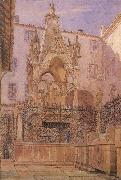 |
George Price Boyce,RWS
|
|
1826-1897
English painter. He was the son of a prosperous wine merchant and pawnbroker. His childhood was spent in London, and in 1846 he was apprenticed to the firm of architects Wyatt & Brandon, where he remained for three years. He was always fascinated by ancient buildings but gradually lost interest in architecture as a career. In 1849, perhaps as a result of meeting David Cox at Betws-y-Coed (Gwynedd, Wales), he decided to become a painter. In the early 1850s Boyce drew landscape and architectural subjects with a fluent watercolour technique derived from Cox. In 1854 Boyce made an extended journey to Italy; he painted views of buildings in Venice and Verona |
|
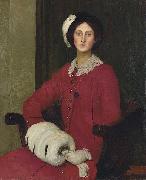 |
George Spencer Watson
|
|
R.O.I., R.P., A.R.A., R.A. (8 March 1869, London - 11 April 1934, London) was an English portrait artist of the late romantic school who sometimes worked in the style of the Italian Renaissance. He studied at the RA Schools from 1889, exhibited at the Royal Academy from 1891. He won Royal Academy Schools Silver Medals in 1889 and 1891, and the Landseer Scholarship in 1892. He was elected R.O.I. in 1900, R.P. in 1904, A.R.A. in 1923, and a Member of the Royal Academy (R.A.) in 1932.
He married Hilda, a dancer and mime artist, and follower of the actor Edward Gordon Craig. They had a daughter, Mary Spencer Watson (1913 - 2006), who became a sculptor. In 1923 he bought Dunshay Manor in the hills of the Isle of Purbeck, after already have spent holidays in Swanage.
He died in London and a memorial exhibition was held at the Fine Art Society in the same year. There is a memorial to him in the north vestibule of St James's Church, Piccadilly, London.
Some of his works are held at Tate Britain, the Harris Art Gallery, Preston and collections in Bournemouth, Liverpool, Plymouth and the National Gallery of Canada. Born in London, Watson studied at the Royal Academy from 1889; he exhibited there from 1891 and also at the Paris salon. Retrospective exhibitions were held at the Galerie Heinemann, Munich in 1912, and at the Fine Art Society in 1914. His work A Lady in Black (1922) is owned by the Tate Collection.
|
|
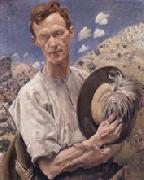 |
George W.Lambert
|
|
Russia-born Australian portrait painter
1873 - 1930
Australian painter, draughtsman and sculptor. He lived for a period in Europe and emigrated to Australia in 1887. He trained under Julian Rossi Ashton, gaining early recognition for his draughtsmanship. In 1901 he studied in Paris at the Acad?mie Colarossi under Auguste Del?cluse (b 1855). He was strongly influenced by the work of Diego Vel?zquez and Edouard Manet. The work of Sandro Botticelli later inspired him to paint in a high key and with an enhanced realism, as in Important People (1914; Sydney, A.G. NSW). He lived in England from 1902 to 1921 |
|
|
|
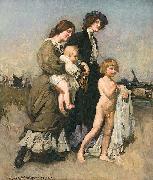 |
George Washington Lambert
|
|
(13 September 1873 - 29 May 1930) was an Australian artist, known principally for portrait paintings and as a war artist during the First World War.
Lambert was born in St Petersburg, Russia, the posthumous son of George Washington Lambert (1833 - 25 July 1873, in London) of Baltimore, Maryland. The younger Lambert's mother was Annie Matilda, nee Firth, an Englishwoman. Mother and son soon moved to Werttemberg, Germany, to be with Lambert's maternal grandfather. Lambert was educated at Kingston College, Yeovil, Somerset. The family, consisting of Lambert, his mother and three sisters, decided to emigrate to Australia. They arrived in Sydney aboard the Bengal on 20 January 1887. |
|
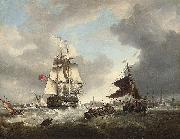 |
George Webster
|
|
Please search for George Webster (painter) in Wikipedia to check for alternative titles or spellings. |
|
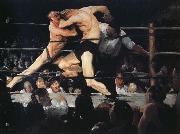 |
George Wesley Bellows
|
|
American Ashcan School Painter, 1882-1925
American painter and lithographer. He was the son of George Bellows, an architect and building contractor. He displayed a talent for drawing and for athletics at an early age. In 1901 he entered Ohio State University, where he contributed drawings to the school yearbook and played on both the basketball and baseball teams. In spring of his third year he withdrew from university to play semi-professional baseball until the end of summer 1904 |
|
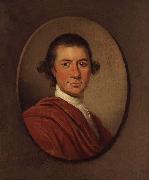 |
George Willison
|
|
Portrait painter who was born in Edinburgh in 1741 and returned there to spend his retirement.
He was a pupil of Mengs in Rome, before Mengs left for Madrid in 1761.
He painted "Boswell" in Rome in 1765 which is now in the Scottish National Portrait Gallery.
Willison was in London from 1767 and exhibited at the Scottish Academy between 1767 - 1770, and at the Royal Academy in 1771 and 1772.
He left London for an opulent retirement in Edinburgh around 1784.
|
|
|
|
|
|
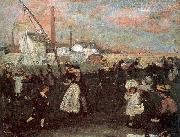 |
Glackens, William James
|
|
American Ashcan School Painter, 1870-1938
American painter and illustrator. He graduated in 1889 from Central High School, Philadelphia, where he had known Albert C. Barnes, who later became a noted collector of modern art. He became a reporter-illustrator for the Philadelphia Record in 1891 and later for the Philadelphia Press. In 1892 he began to attend evening classes in drawing at the Pennsylvania Academy of Fine Arts, studying under Thomas Anshutz. In the same year he became a friend and follower of Robert Henri, who persuaded him to take up oil painting in 1894. Henri's other students, some of whom were referred to as the Ashcan school, included George Luks |
|
|
|
|
|
|

